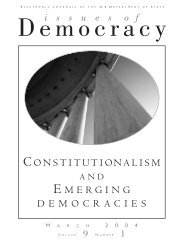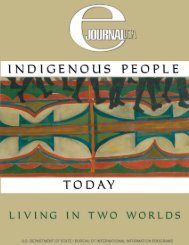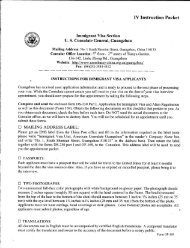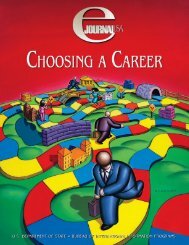s. history us history us history - Embassy of the United States
s. history us history us history - Embassy of the United States
s. history us history us history - Embassy of the United States
- No tags were found...
Create successful ePaper yourself
Turn your PDF publications into a flip-book with our unique Google optimized e-Paper software.
CHAPTER 2: THE COLONIAL PERIODOUTLINE OF U.S. HISTORYAN EXCEPTIONAL NATION?The <strong>United</strong> <strong>States</strong> <strong>of</strong> America did not emerge as a nation until about 175years after its establishment as a group <strong>of</strong> mostly British colonies. Yet from <strong>the</strong>beginning it was a different society in <strong>the</strong> eyes <strong>of</strong> many Europeans who viewedit from afar, whe<strong>the</strong>r with hope or apprehension. Most <strong>of</strong> its settlers — whe<strong>the</strong>r<strong>the</strong> younger sons <strong>of</strong> aristocrats, religio<strong>us</strong> dissenters, or impoverished indenturedservants — came <strong>the</strong>re lured by a promise <strong>of</strong> opportunity or freedom notavailable in <strong>the</strong> Old World. The first Americans were reborn free, establishing<strong>the</strong>mselves in a wilderness unencumbered by any social order o<strong>the</strong>r than that<strong>of</strong> <strong>the</strong> primitive aboriginal peoples <strong>the</strong>y displaced. Having left <strong>the</strong> baggage <strong>of</strong>a feudal order behind <strong>the</strong>m, <strong>the</strong>y faced few obstacles to <strong>the</strong> development <strong>of</strong> asociety built on <strong>the</strong> principles <strong>of</strong> political and social liberalism that emergedwith difficulty in 17th- and 18th-century Europe. Based on <strong>the</strong> thinking <strong>of</strong> <strong>the</strong>philosopher John Locke, this sort <strong>of</strong> liberalism emphasized <strong>the</strong> rights <strong>of</strong> <strong>the</strong>individual and constraints on government power.Most immigrants to America came from <strong>the</strong> British Isles, <strong>the</strong> mostliberal <strong>of</strong> <strong>the</strong> European polities along with The Ne<strong>the</strong>rlands. In religion, <strong>the</strong>majority adhered to vario<strong>us</strong> forms <strong>of</strong> Calvinism with its emphasis on bothdivine and secular contractual relationships. These greatly facilitated <strong>the</strong>emergence <strong>of</strong> a social order built on individual rights and social mobility. Thedevelopment <strong>of</strong> a more complex and highly structured commercial society incoastal cities by <strong>the</strong> mid-18th century did not stunt this trend; it was in <strong>the</strong>secities that <strong>the</strong> American Revolution was made. The constant reconstruction <strong>of</strong>society along an ever-receding Western frontier equally contributed to a liberal-democraticspirit.In Europe, ideals <strong>of</strong> individual rights advanced slowly and unevenly; <strong>the</strong>concept <strong>of</strong> democracy was even more alien. The attempt to establish both incontinental Europe’s oldest nation led to <strong>the</strong> French Revolution. The effort todestroy a ne<strong>of</strong>eudal society while establishing <strong>the</strong> rights <strong>of</strong> man and democraticfraternity generated terror, dictatorship, and Napoleonic despotism. In <strong>the</strong>end, it led to reaction and gave legitimacy to a decadent old order. In America,<strong>the</strong> European past was overwhelmed by ideals that sprang naturally from <strong>the</strong>process <strong>of</strong> building a new society on virgin land. The principles <strong>of</strong> liberalismand democracy were strong from <strong>the</strong> beginning. A society that had thrown <strong>of</strong>f<strong>the</strong> burdens <strong>of</strong> European <strong>history</strong> would naturally give birth to a nation thatsaw itself as exceptional.THE WITCHES OF SALEMIn 1692 a group <strong>of</strong> adolescent girls in Salem Village, Massach<strong>us</strong>etts, becamesubject to strange fits after hearing tales told by a West Indian slave. Theyacc<strong>us</strong>ed several women <strong>of</strong> being witches. The townspeople were appalled butnot surprised: Belief in witchcraft was widespread throughout 17th-centuryAmerica and Europe. Town <strong>of</strong>ficials convened a court to hear <strong>the</strong> charges <strong>of</strong>witchcraft. Within a month, six women were convicted and hanged.The hysteria grew, in large measure beca<strong>us</strong>e <strong>the</strong> court permitted witnessesto testify that <strong>the</strong>y had seen <strong>the</strong> acc<strong>us</strong>ed as spirits or in visions. Such“spectral evidence” could nei<strong>the</strong>r be verified nor made subject to objectiveexamination. By <strong>the</strong> fall <strong>of</strong> 1692, 20 victims, including several men, had beenexecuted, and more than 100 o<strong>the</strong>rs were in jail (where ano<strong>the</strong>r five victimsdied) — among <strong>the</strong>m some <strong>of</strong> <strong>the</strong> town’s most prominent citizens. When <strong>the</strong>charges threatened to spread beyond Salem, ministers throughout <strong>the</strong> colonycalled for an end to <strong>the</strong> trials. The governor <strong>of</strong> <strong>the</strong> colony agreed. Those stillin jail were later acquitted or given reprieves.Although an isolated incident, <strong>the</strong> Salem episode has long fascinatedAmericans. Most historians agree that Salem Village in 1692 experienced akind <strong>of</strong> public hysteria, fueled by a genuine belief in <strong>the</strong> existence <strong>of</strong> witchcraft.While some <strong>of</strong> <strong>the</strong> girls may have been acting, many responsible adultsbecame caught up in <strong>the</strong> frenzy as well.Even more revealing is a closer analysis <strong>of</strong> <strong>the</strong> identities <strong>of</strong> <strong>the</strong> acc<strong>us</strong>edand <strong>the</strong> acc<strong>us</strong>ers. Salem Village, as much <strong>of</strong> colonial New England, wasundergoing an economic and political transition from a largely agrarian, Puritan-dominatedcommunity to a more commercial, secular society. Many <strong>of</strong><strong>the</strong> acc<strong>us</strong>ers were representatives <strong>of</strong> a traditional way <strong>of</strong> life tied to farmingand <strong>the</strong> church, whereas a number <strong>of</strong> <strong>the</strong> acc<strong>us</strong>ed witches were members <strong>of</strong> arising commercial class <strong>of</strong> small shopkeepers and tradesmen. Salem’s obscurestruggle for social and political power between older traditional groups and anewer commercial class was one repeated in communities throughout American<strong>history</strong>. It took a bizarre and deadly detour when its citizens were sweptup by <strong>the</strong> conviction that <strong>the</strong> devil was loose in <strong>the</strong>ir homes.The Salem witch trials also serve as a dramatic parable <strong>of</strong> <strong>the</strong> deadlyconsequences <strong>of</strong> making sensational, but false, charges. Three hundred yearslater, we still call false acc<strong>us</strong>ations against a large number <strong>of</strong> people a“witch hunt.”3435












